After the launch, the lack of wind was perfect for a kayak trip to Bull Island. These conditions were optimal too for spotting a loggerhead, or perhaps to hear its gasping exhalation. April is the month when I have observed these marine reptiles before the females begin their nesting in May. Paddling steady with the significant help of outgoing tide, I tuned into the waters for loggerhead sign.
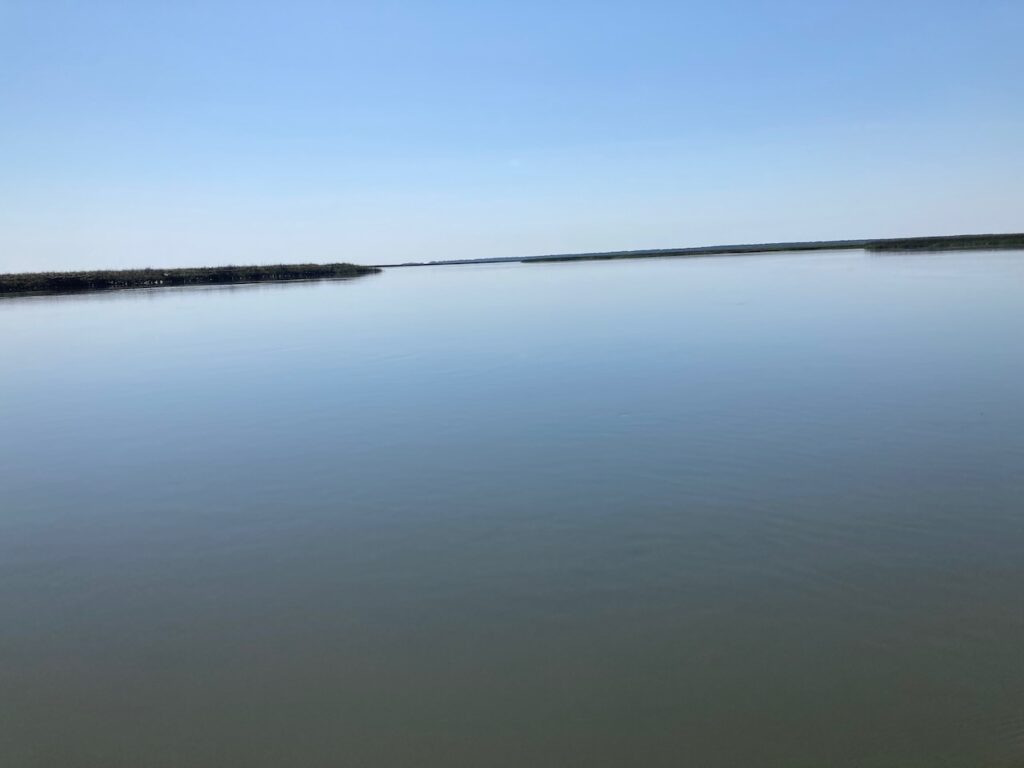
Out of the creek into Bulls Bay the waters continued to be windless and placid, only roiled by the strong ebb. Crab pot buoys were scattered, and danced on the surface with the surging tide. Progress was steady and sure on the course for the Northeast Point, though no loggerheads appeared. I anticipated being the sole person on the strand.
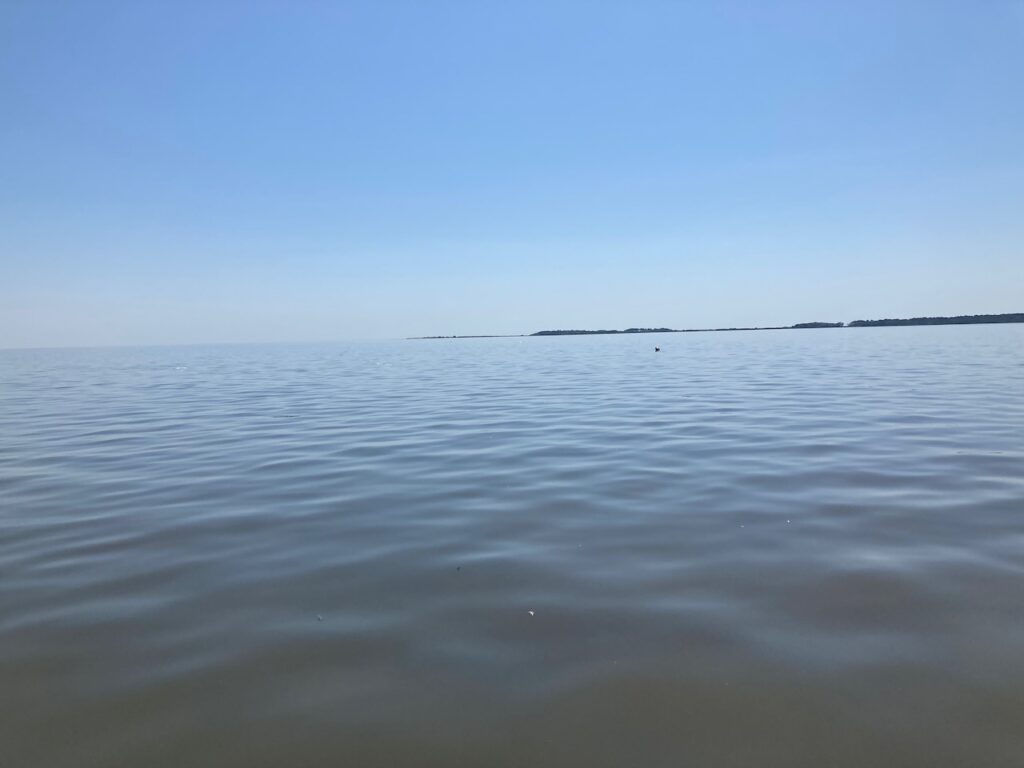
But how wrong I was. As I drew closer, I noticed many people on the shore, and the largest group seemed packed together. Into the picture from the south came two watercraft, the second larger than the first, and appearing to be the ferry Caretta. They passed the groups on the strand, but eventually turned and came in for a beach pickup. I landed at the same time, and could see the people were elementary school students along with their teachers and Coastal Expeditions guides. The captains and crew of the two craft managed the embarking of all these students, and headed off for their return trip to Garris Landing, slowing for the dolphin-viewing pleasure of their passengers.
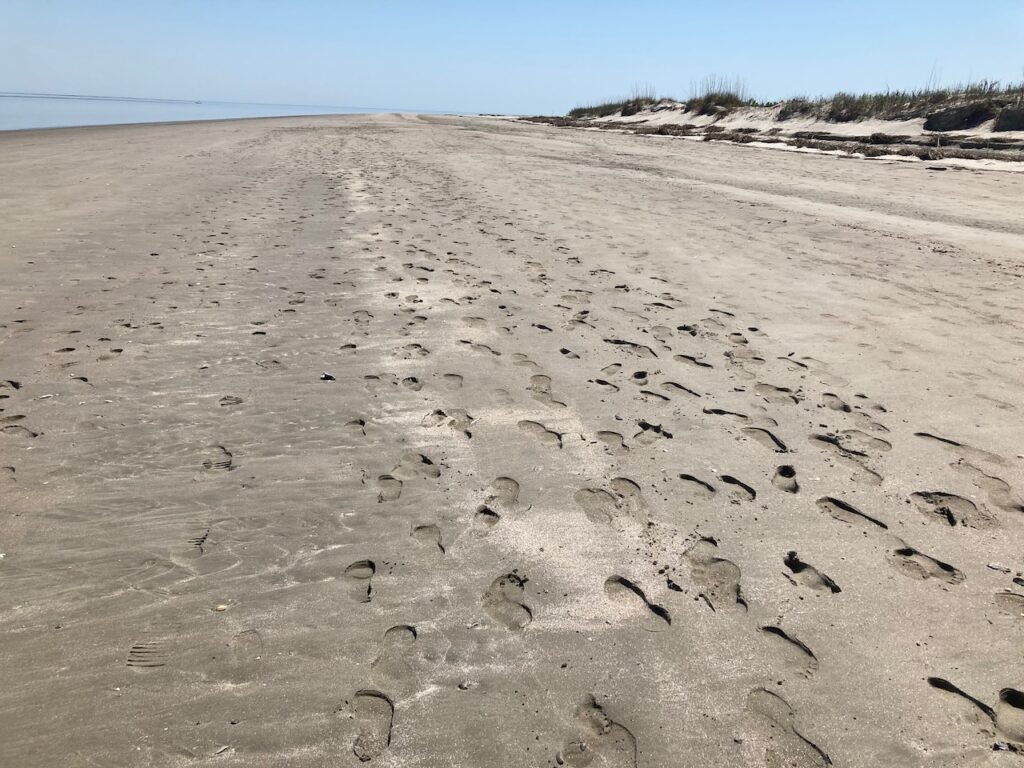
I was happy to share the point with this group, surely a highlight of their school week (month? year?). I was left with the island to myself, notwithstanding the mass of footprints from the students’ visit. The air was remarkably clear, and the view with the naked eye allowed the Cape Romain lighthouses to come into focus. The forested areas of Lighthouse and Cape Islands were also visible. I recalled a 2006 encounter on Cape Island with future loggerhead royalty.
The tide would fall for another two and a half hours, and I was able to remain on the low end of the intertidal area to give space to the Closed Area set aside for nesting birds. The footprints reduced to a smaller group heading down the beach. As I rounded the point to head south, the predicted south wind began to ruffle the ocean surface. The footprints ahead reduced to two pairs, and then solely the tiny prints of ghost crabs. A group of barn swallows perched on swaying reeds above a dune. A variety of shorebirds probed the exposed ancient mudflats along the water’s edge for food. Shells at mid and high tide lines stretched out south toward the distant Boneyard.
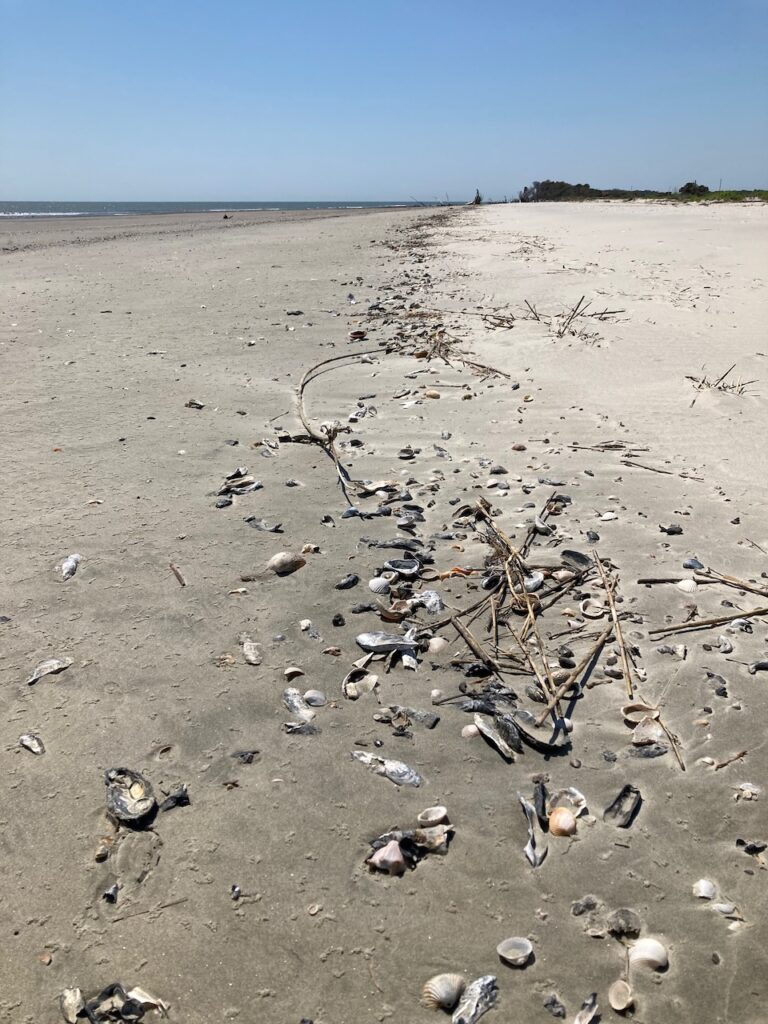
Upon my return to the Northeast Point, occupied by my solitary kayak, I waited for the change of the tide. The south wind had settled in and changed the atmosphere, hiding the lighthouses. I soon began the return trip by walking my floating kayak along the shore to the west. I passed by numerous “walking” shells, the empty exoskeletons (tulips, whelks, moon snails) occupied by hermit crabs, marching along in the shallows. Before the shallows turned to mud, I embarked and began the paddle home.
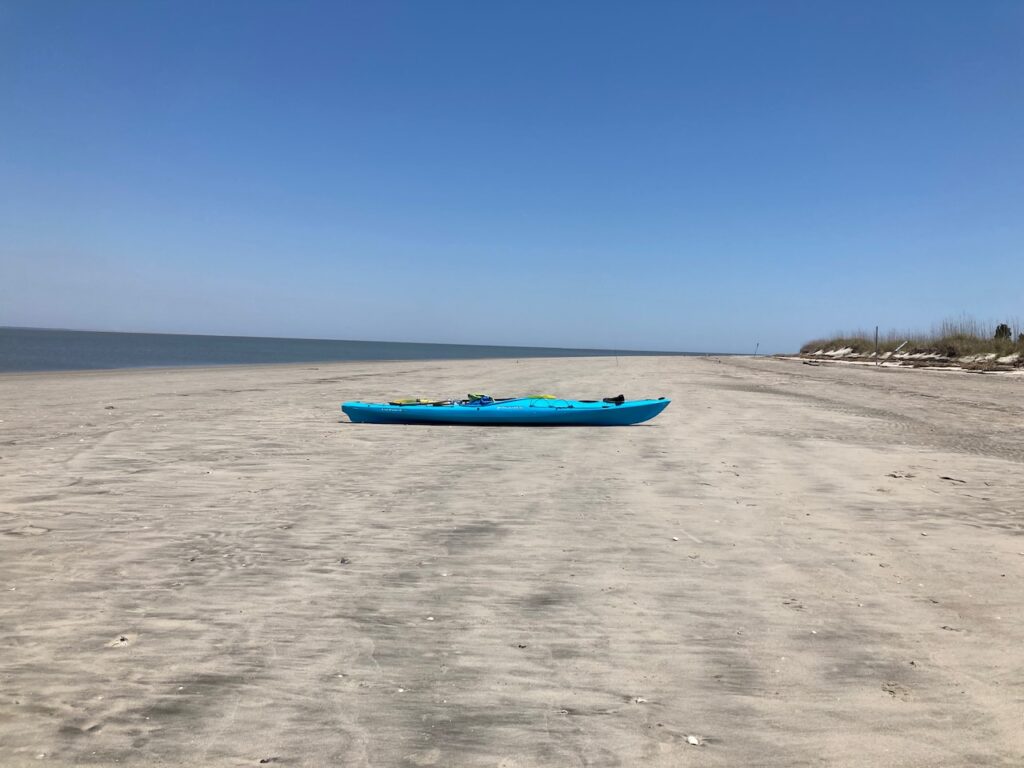
I adopted a straight course for the opening to Anderson Creek, perhaps two miles away. I encountered what I thought was the tide line, but instead found a very familiar shoal, one that I had named twenty years ago “Shortcut Shoal.” The water was around a foot deep, enough to continue to float the kayak but shallow enough that every paddle stroke touched sand. Occasionally a light colored mass appeared – loggerhead? I finally turned to inspect one of these “bodies”, and found it was a mass of yellow sea whips, not plants but animals in the soft coral family. I would see more of these clumps before returning to deeper water, a pair of dolphins providing moments of companionship.
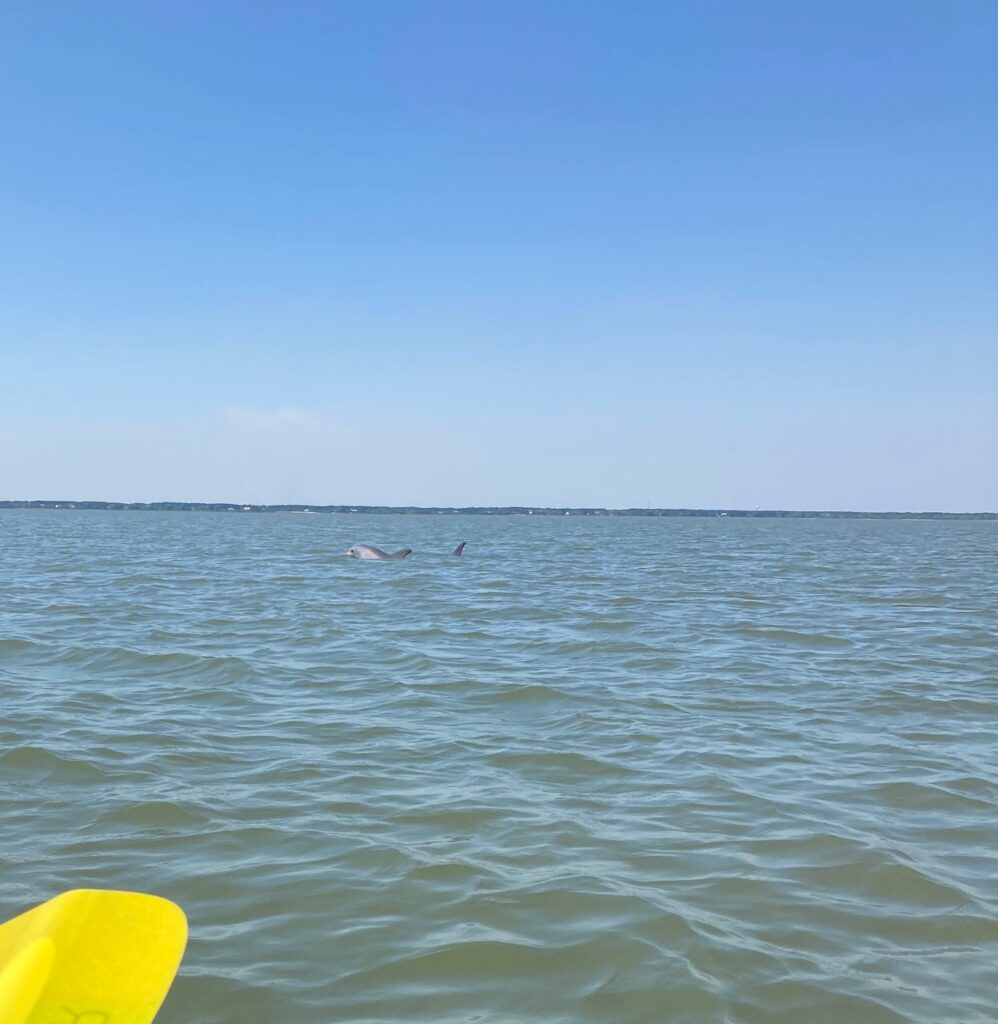
The paddling became unconscious and hypnotic heading to the creek mouth, marked by raised shell rakes on both sides. Crab pot buoys of different colors were everywhere. A salmon-colored object appeared, and then dove – my first loggerhead sighting of 2023. I will see more in the creeks and bays this year, and note their crawls on the refuge’s beaches. I experienced other seasonal firsts in this twenty-four hour period – a male painted bunting and a ruby-throated hummingbird at their respective feeders at home.
Back in the creek, brown pelicans utilized the creek edge on their gliding flights. Other flyers crossed my course at a right angle, first one bumblebee, then others. More pelicans cruised the edge as I approached the Intracoastal Waterway. It was about one and a half hours after the low tide, and I hoped for plenty of water at the boat ramp. Sighting through the pier pilings, the view of an egret was not encouraging, and on final approach saw it standing in the shallow water covering little leg. Fully committed, I plowed through pluff mud and made it to the water’s edge, extracted my legs from the hull and stepped out into pluff mud, a coating for my shoes, shorts, and boat. A messy finish to a wonderful excursion.
Entertaining as always
Sorry no coated-in-pluff-mud selfie, for further entertainment.
Sounds like the perfect ending to a fabulous day on the water. Fun read. Felt like I was along for the ride!
It was fabulous. Negotiating with the tide at times means interacting with the pluff mud.
Glad u saw the Loggerheads.
Me too.
Thanks, Bob for inviting us along on your adventure into the Refuge. I miss it, and reading your lines and viewing your pictures always brings me right back to the salt air.
Will keep the salt air coming your way.
Th!anks for sharing Bob! Today is our first day back from the Bahamas and I needed those great pictures to help with our re-entry to the work world
Happy trails on your re-entry.
Last time I was out on that point last year there was a big nest that had been dug up and all eggs destroyed/eaten by coyotes – and you could see how they had harassed the tank-tract-making creature on her return to the sea. Coyotes are not native to SC, and they are wreaking havoc. I think they are particularly bad for the barrier islands – eating bird eggs (plover) turtle eggs etc
Yes the coyotes made their appearance on the island a few years ago. The nests on Bull are predated much more than the nests further north in the refuge. That is a good thing, since the northern islands have the preponderance of nests. Bull has an extensive maritime forest, good habitat for coyotes and a large population of raccoons. We are fortunate that feral pigs have not made it out to any of the refuge islands (yet!).